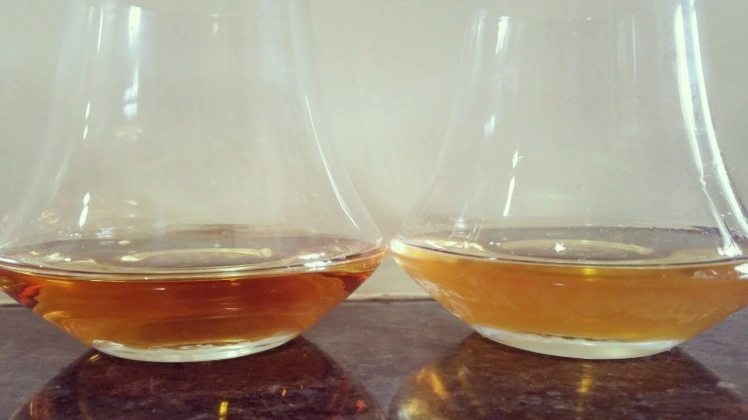Glass on the left is a non-chill filtered whisky at ambient temperature and the one on the right is the same whisky with an ice cube added to it. So why do some whiskys go cloudy while others don’t?
The presence of natural fatty acids, esters and proteins in whisky cause it to go cloudy when cooled. They originate from the barley and persists through distillation but some are also imparted from the casks during maturation. These fatty acids, esters and proteins are soluble in alcohol, but insoluble in water and so clump together as micelles (a spherical arrangement of lipid molecules due to its polarity) when cooled (or when you add ice to it!) and give the hazy appearance.
People who aren’t familiar with this phenomenon could think they have an inferior or flawed whisky and is perceived as a ‘fault’ by many uninformed consumers. So commercially it is often removed to enhance the glossy golden appearance we associate with whisky. This is done by a process called chill filtration during which the temperature of the whisky is dropped to 0°C for single malts and -4°C for blends. The grain whiskey in blends usually have a lower natural concentration of fatty acids and the lower temperature aids in its removal. The chilled whisky is then passed through a series of compact metallic meshes or paper filters under pressure to remove the hazy residue.
Whiskies above 46% ABV (alcohol by volume) do not require chill filtration, as the higher alcohol level prevents haze formation. But a non-filtered whisky that is 46% ABV or lower will go cloudy when water or ice is added and when the whisky is cooled. So the solubility of the haze particles is not only dependent on temperature but also the ethanol concentration.
Lastly the most important question – is there any difference in taste between chill filtered and non-chill filtered whisky? This is a quite a debatable topic and often not talked about or disclosed on whiskey labels. But if you’re about to drop $60 on a bottle of Single Malt Whisky, it is something to consider. According to a study conducted by German scientist Horst Luening, there was no significant difference perceived between chill filtered and non-chill filtered whisky. (Incase you want to read more about it – https://www.whisky.com/information/knowledge/science/study-on-the-chill-filtration-of-scotch-single-malt-whiskies.html )Some experts argue against it saying filtration alters the flavous and mouthfeel of whisky, but in reality it is difficult to compare as not many distilleries releases the same batch of whisky in a chill filtered and non-chill filtered form. So whether you like you whisky at cask strength or chill filtered, drink it before the ice melts !

Very knowledgeable, Ms. Martins.
I’m guessing majority of whiskes today are chill filtered, yes?
LikeLike
Thanks Hemant, glad you liked the post! And yes, sadly most whiskies are filtered but a few companies are releasing small batch unfiltered whiskies as well. You should keep a look out for those.
LikeLike